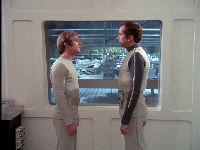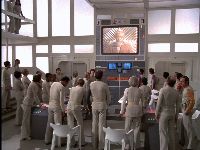SFX
by Martin Willey
Rear projection was first used in the 1930 musical comedy Just Imagine and was used extensively, until it was replaced by post-production compositing (blue or green screen). A background is filmed and printed as film. The film is projected onto a large screen, and on the other side are the foreground actors and set, with the camera. The problem is the background plate is always fainter than the foreground, because it is seen through the projection screen (and is being re-filmed). The leading British expert in rear and front projection was Charles Staffell, who worked on 2001: A Space Odyssey and most of the Bond movies, and was based in Pinewood.
It is only used in Space: 1999's first episode.

Breakaway, Carter and Koenig talk in front of the window to the Eagle hangar. The Eagle hangar was filmed some weeks before at the Bray Studios. At Pinewood studios, the window is placed in front of the rear projection screen and the Bray footage is projected as the actors talk.
The following video by Roberto Baldassari demonstrates how the effect was created.

At least some of the Big Screen shots in Main Mission are rear projection, enabling the camera to move as the actors react to the screen. However, other shots are optical compositing, and this became the preferred way to film the screen.
A related technique is front projection, in which the projection screen is a special highly reflective material, and the film projector is on the same side as the camera. It was used in 2001: A Space Odyssey (1968), On Her Majesty's Secret Service (1969) and Superman (1978). The highly reflective "Scotchlite" material used for front projection screens was used in Space: 1999, with small squares added to SFX models; the reflected light looks like windows.
A modern version of rear projection are large LED video screens. The most advanced form of this is the ILM Stagecraft set (also called "the volume"), a semi-circular enclosed set in which the digital background on the LEDs is linked to the camera movement.
Copyright Martin Willey